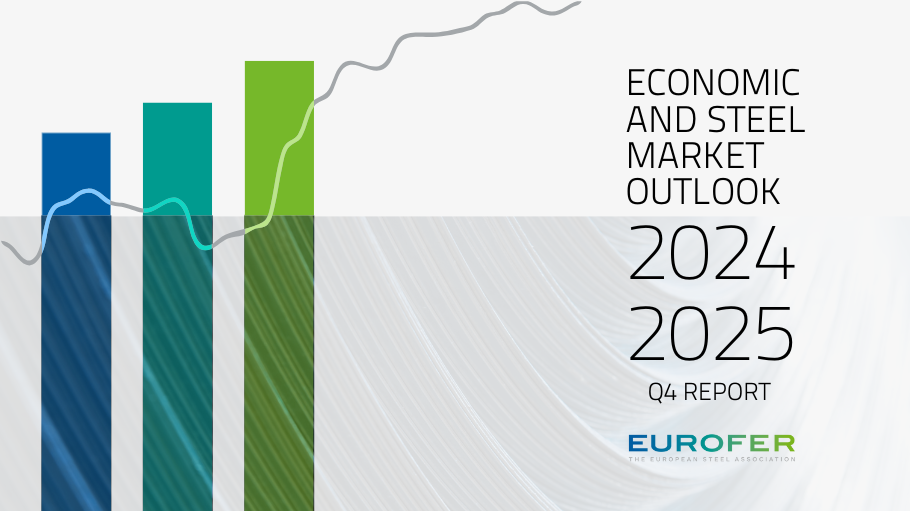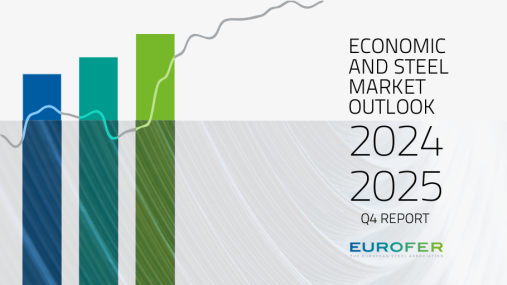
Publications » Economic and market outlook » Economic and steel market outlook 2024-2025, fourth quarter
Economic and steel market outlook 2024-2025, fourth quarter
Downloads and links
Recent updates

The negative trend in the steel market which began in the second half of 2022 has continued up to the second quarter of 2024. The severe consequences of the war in Ukraine and other global geopolitical tensions, along with the deteriorating manufacturing outlook across the EU and uncertainty in the overall economic environment, have continued to take their toll. Apparent steel consumption in the EU continued to decrease (-1.3%) in the second quarter of 2024, confirming the negative trend observed in the preceding quarter (-3%). After a significant recession (-8.3%) in 2022, persistent downside factors such as ongoing conflicts, uncertainty surrounding energy prices and inflation combined with a worsened economic outlook have further negatively impacted apparent steel consumption in 2023. However, the data reveal a less pronounced contraction than previously expected (-6%, revised upwards from -9%) compared to 2022, marking the fourth annual recession in the last five years.
This downward trend is set to impact the overall forecast for 2024, against expectations earlier in the year of a possible improvement in the demand outlook. As a result, in 2024, due to poor developments in the industrial outlook and decreasing demand from steel-using sectors (particularly construction and automotive), apparent steel consumption is projected to experience another recession, albeit moderate (-1.8%, revised downwards from +1.4% of the previous forecast). The overall evolution of steel demand remains subject to high uncertainty. A modest recovery is foreseen in 2025, however resulting in consumption volumes far below pre-pandemic levels.
In the second quarter of 2024, apparent steel consumption dropped again (-1.3%), after the decrease recorded in the preceding quarter (-3%). The total volume in the second quarter of 2024 stood at 34.8 million tonnes.
The current downturn in EU apparent steel consumption, reflecting poor demand conditions, began in the second quarter of 2022, due to war-related disruptions, along with unprecedented rises in energy prices and production costs. Demand conditions have been worsening considerably since then, and this negative cycle continued until the second quarter of 2024, also fuelled by growing global economic uncertainty, higher interest rates and overall manufacturing weakness.
Domestic deliveries mirrored the evolution in demand and contracted (-1.7%, further to -5.6% in the preceding quarter). In 2022, deliveries plummeted (-9.1%), reflecting the sharp deterioration in demand. As a result of persisting negative trends throughout the year, domestic deliveries markedly dropped again (-4.6%) in 2023.
Imports into the EU including semi-finished products slightly decreased (-1.5%) in the second quarter of 2024, after a rise in the preceding quarter (+12%). It is worth noting that the drops in imports reflect weak demand conditions, as apparent consumption declined (-1.3%) in the same period. However, in absolute volumes the share of imports out of apparent consumption has remained considerably high in historical terms throughout 2023 and up to the second quarter of 2024, rising to 28% from 27% in the first quarter.
EU steel-using sectors
In the second quarter of 2024, the Steel Weighted Industrial Production index (SWIP) markedly dropped for the second consecutive time (-2.1%, after -2.4%). Until the end of 2023, EU steel-using sectors’ output continued to show resilience and grow, albeit at a slower pace (+0.9%, revised downwards from +1.2%). This was despite the prolonged impact of Russia’s invasion of Ukraine, overall manufacturing weakness and global geopolitical tensions, along with above-average energy prices.
The positive trend in overall SWIP, started after the pandemic, continued up to the fourth quarter of 2023, in spite of soaring energy prices impacting production costs, component shortages and lower output that began to take their toll on total production activity in steel-using sectors in the second half of 2022. The deterioration of the economic and industrial outlook in the EU – particularly due to high inflation and the subsequent interest rate hike by the European Central Bank (ECB) – had only a limited impact on steel-using sectors’ output up to the end of 2023, with the exception of the construction sector.
The latest developments in the SWIP index reflect a continued downturn in the construction, mechanical engineering, domestic appliances and metalware sectors, as well as a slowdown in the automotive sector. The latter had experienced growth for seven consecutive quarters, although output remained well below 2019 levels. The construction sector, which accounts for 35% of steel consumption in the EU, entered recession in the third quarter of 2022, and this trend continued up to the second quarter of 2024 (0.4%, after -2.6% in the preceding quarter). Recession is expected to persist until the end of 2024.
Ongoing economic uncertainty is set to continue taking its toll on growth also in the upcoming quarters. SWIP resilience is therefore expected to come to an end in 2024 as steel-using sectors’ output growth is projected to experience a steeper drop (-2.7%, revised downwards from -1.6%). A more modest recovery is anticipated in 2025 (+1.6%, also revised downwards from +2.3%).
Conclusions
The ongoing economic uncertainty is set to continue affecting steel market growth from the demand side over the upcoming quarters:
1. Despite EU industry proving quite resilient throughout 2023, the outlook for the second half of 2024 remains dominated by a worsening combination of uncertainties in energy prices, weak manufacturing sectors’ conditions, inflation above target levels, severe geopolitical tensions and economic challenges driven by high interest rates. Despite recent monetary easing, its effects on the economic cycle will not be visible in the short-term.
2. While output grew more than expected (+3.2%) in 2022, SWIP growth in 2023 slowed down, achieving a lower-than-estimated growth (+0.9% vs. +1.2%), with wide differences among individual EU economies and industrial sectors.
3. In 2024, growth in steel-using sectors is projected to drop more severely than formerly estimated (-2.7% vs. -1.6%), due to the second recession in a row in the construction sector and the first (since 2020) in the automotive sector. Persistent geopolitical tensions and the lagged impact on monetary easing weighted on the overall manufacturing sector. A more moderate growth is expected in 2025 (+1.6%, revised downwards from +2.3%).

Download this publication or visit associated links
Brussels, 28 July 2025 — The European steel value chain is at a critical juncture. Deindustrialization is accelerating across both steel production, distribution and processing, threatening the resilience, competitiveness, and long-term sustainability of a sector essential to Europe's strategic autonomy and industrial base.
Brussels, 29 July 2025 – The proposal for a ‘highly effective’ new trade measure to counter global overcapacity and preserve the European steel industry’s capacities, published yesterday by France on behalf of a group of 11 Member States, is a timely initiative. The non-paper sets a clear course towards a comprehensive steel trade measure to replace the current safeguard regime at a critical moment, as the negative impacts of global overcapacity on the European steel industry continue to grow, says the European Steel Association (EUROFER).
Brussels, 28 July 2025 – The deal on tariffs struck by the EU with the U.S. limits the damage in the current circumstances, but the impact on European steel remains dramatic as long as 50% tariffs are still applied. A potential joint action EU-U.S. to address global overcapacity and a possible return to a tariff-rate quota system for EU exports to the U.S., as hinted at by Commission President Ursula von der Leyen, are still vague and lack the necessary details to the bring the economic certainty needed by EU steel producers, says the European Steel Association.